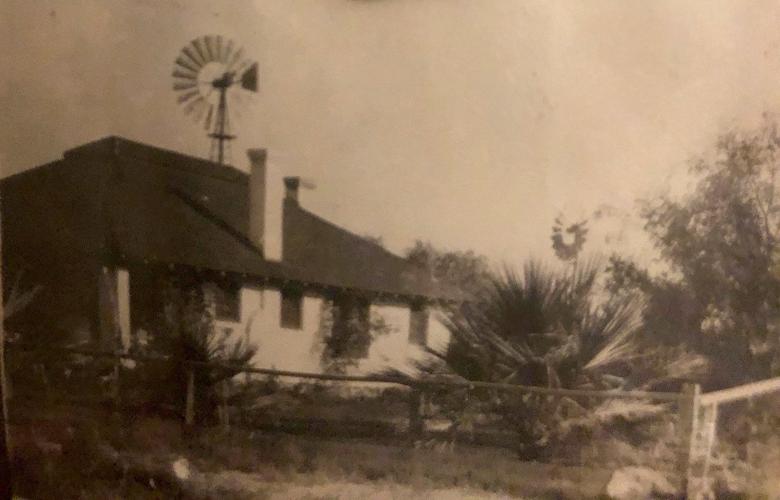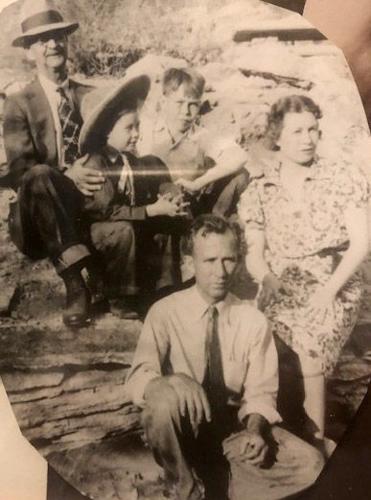In 1909, Hallah C. “Hal” Kinnison and his family arrived in the Old Pueblo from Dallas and moved into a home on the northeast corner of The Speedway (now Speedway) and Mountain Avenue.
The address, later listed as 1317 E. Speedway, is where the University of Arizona Aerospace and Mechanical Engineering building is now located.
They came for his wife’s health and spent the next two winters here, then Kinnison returned to Dallas to handle his business affairs.
Kinnison, who was born in 1869 in Shepherdsville, Kentucky, had wed Emily Gohlke in Louisville in 1898. Their son Henry Almyr Kinnison was born in 1900, followed two years later by John Emmett Kinnison.
The family had moved to Dallas by 1905, and Kinnison worked as a mechanical engineer, with his younger brother Henry, at their enterprise Kinnison Brothers, a refrigeration and heating business.
By 1911, Kinnison likely saw a future in Tucson, and along with Henry bought the Durazo Ranch located on the Santa Cruz River and Indian School Road (now Ajo Way).
The ranch consisted of a small three-room home and 320 acres of fertile land and was in eyeshot of the Tucson Indian School. They added more land as the years passed.
By 1914-15, Kinnison is believed to have had the land producing crops and is known to have been selling work horses, dry wood for stoves, and a 7-inch centrifugal pump from the site.
Around 1919, he began an experiment of offering part of his large-scale irrigated farm, which had barley and alfalfa growing on it, to other cattlemen to pasture their livestock, which proved very profitable and helped begin a new industry in town.
Before large-scale irrigated farming in Tucson like Kinnison’s farm and L.H. Manning’s farm, south of Tucson, stockmen had to ship their surplus cattle to other parts of the country for fattening. But after this industry was created, beef could be finished here for local consumption.
While Kinnison was experimenting with cattle feeding, his wife and her neighbor began secretly experimenting, during prohibition, with wine making.
Over the next decade, Hal and Emily Kinnison saw their family grow, as son Emmett married Eva Milam and they had son John E. Kinnison Jr.; and son Almyr wed Jane Hoffman and they had children Henry A. Kinnison Jr. and Joanna Kinnison.
Opha Probasco (namesake of Opha Road) worked at the Kinnison Farm as a 10-year-old. By 1930, Kinnison “had a large peach orchard besides a lot of farm ground where he planted various items such as sugar cane,” used as livestock feed, Probasco said. “He planted a lot of potatoes and I help(ed) dig the potatoes and put them in a sack. I worked all afternoon and made a quarter plus a small sack of potatoes. (The Great) Depression was here so I was lucky to get a quarter.”
The same year, it appears that the Kinnison Farm was starting to decline, as it offered up its dairy herd and equipment for sale.
By 1935, R.C. “Bob” Locke had taken over the old Kinnison Farm and started the first “organized” horse racing track. The track was a half-mile oval with flat turns. Locke would later go on to be a part of the Rillito Race Track.
In the meantime, while still running the Kinnison Farm, in 1914, Kinnison began buying up land along the Pantano River, beginning with 112 acres, from homesteaders William and Ruth Cole. Over the next six years he would make two more purchases of land south of this original purchase, along the Pantano River.
At some point, Kinnison constructed a canal and earthen dam and formed an irrigation reservoir that would come to be called the Kinnison Reservoir, Kinnison Dam or Kinnison Lake, on his property from runoff from the river in order to irrigate his crops. It’s very likely he built a home on the property as well.
In 1927, Jack Frye, later president of TWA Airlines, piloted a goodwill flight from Douglas to Tucson, and wrote poetically in his log, “The plane’s shadow slips along the Kinnison canal, down to the lake, then over the cultivated plots and Tucson unfolds in the distance.”
In 1933, Kinnison lost this property, likely due to the Depression. At the time of the sale, the property was listed as 12 miles east of town and having about 350 acres, with a large dam and lake for irrigation on the Pantano River, and was being sold for $5,500 by a Texas bank.
This land soon after became a guest ranch, called El Rancho Pantano, and in time became the property of the Atterbury family. It’s now a subdivision called Lakeside Park, and the old Kinnison Lake is now Lakeside Lake.
In 1920, while still owning the Kinnison Farm and Kinnison Lake properties, the Kinnison brothers further expanded their small ranching and farming empire, buying the Inter-Ocean Ranch, about 18 miles southeast of Oracle, on the north side of the Santa Catalina Mountains.
In 1923, Emmett and his new bride Eva were managing the ranch in the mountains. Emmett apparently was an intellectual and not well-suited to run a ranch so around 1925, Almyr and his wife Jane were living up on the ranch, also.
In the years 1926 and 1927, Hal Kinnison drove at least 500 head of cattle to Oracle, likely to be put on the train for Tucson. Kinnison also expanded the property by purchasing more nearby mountain land.
Six years later, likely due to the economic hardships of the Depression, the Kinnison family lost the ranch. At the time of the sale, the ranch consisted of 960 acres of deeded land, about 22 sections (about 14,000 acres) of state leased land, and was being sold for $25,000 by a Texas bank. The property was known as the U Circle Ranch for many years.
Kinnison’s wife, Emily, died in 1934 and the next year he returned to Dallas to live permanently.
Joanna recalls: “I only saw grandpa once a year, after he moved back to Texas. Around Christmas time, every year he brought a gunny sack of pecans for us. To keep us kids entertained, he would often walk on his hands and wiggle his ears but not at the same time.”
In October 1947 Kinnison died, in Dallas.
Today, Kinnison’s name lives on in Tucson through the relatively new street name Kinnison Wash Loop, as well as on the Kinnison Wash itself.
Note: Kinnison’s name has appeared in the newspaper several times since his death as “Hallan”, but according to his granddaughter Joanna, his name was “Hallah.”





